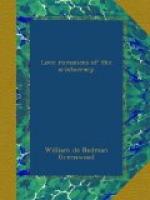A French fortune-teller had warned him that “he would not survive his wife a year”; and, as he neared Osnabrueck, the home of his brother, the Prince Bishop, his fatal illness overtook him.
“When he arrived at Ippenburen, he was quite lethargic; his hand fell down as if lifeless, and his tongue hung out of his mouth. He gave, however, signs enough of life by continually crying out, as well as he could articulate, ‘Osnabrueck!’ ‘Osnabrueck!’”
As night fell the sweating horses galloped into Osnabrueck; an hour later George died in his brother’s arms, less than twelve months after his wife had drawn her last breath in her fortress-prison of Ahlden.
The Duchess of Kendal was disconsolate.
“She beat her breasts and tore her hair, and, separating herself from the English ladies in her train, took the road to Brunswick, where she remained in close seclusion about three months.”
Returning to England, to the only solace left to her—her money-bags—she spent the last seventeen years of her life alternating between her villas at Twickenham and Isleworth. George had promised her that if she survived him, and if it were possible, he would revisit her from the spirit world.
“When,” to quote Walpole again, “one day a large raven flew into one of the windows of her villa at Isleworth, she was persuaded that it was the soul of the departed monarch, and received and treated it with all the respect and tenderness of duty, till the Royal bird or she took their last flight.”
Thus, shorn of all her powers and splendour, in obscurity, and hoarding her ill-gotten gold, died the most remarkable woman who has ever figured in the British Peerage. Her vast fortune was divided between her two “nieces,” one of whom, created by her father, George, Countess of Walsingham, became the wife of that polished courtier and heartless man of the world, Philip, fourth Earl of Chesterfield.
CHAPTER XXV
THE ROMANCE OF FAMILY TREES
Such are a few of the scenes which arrest the eyes as the panorama of our aristocracy passes before them; but it would require a library of volumes to do anything like adequate justice to the infinite variety of the dramas it presents. There is for instance a whole realm of romance in the origins of our noble families whose proud palaces are often reared on the most ignoble of foundations; and whose family trees flaunt, with questionable pride, many a spurious branch, while burying from view the humble roots from which they derive their lordly growth.
Although Cobden’s assertion that “the British aristocracy was cradled behind city counters” errs on the side of exaggeration, there is no doubt that in the veins of scores of the proudest English peers runs the blood of ancestors who served customers in City shops.
When, a couple of centuries ago, John Baring, son of the Bremen Lutheran parson, Dr Franz Baring, opened his small cloth manufactory on the outskirts of Exeter, his most extravagant ambition was to build up a business which he could hand over to his sons, and to provide a few comforts for his old age; if any one had told him that he was laying the foundations of four families which should hold their heads proudly among the highest in the land he would no doubt have laughed aloud.




